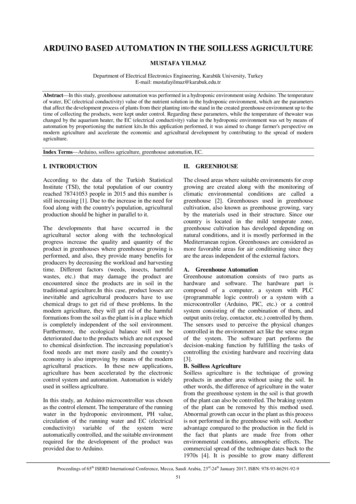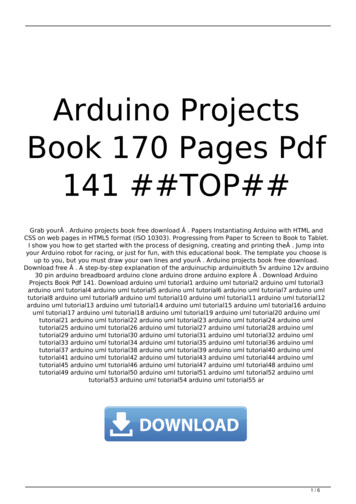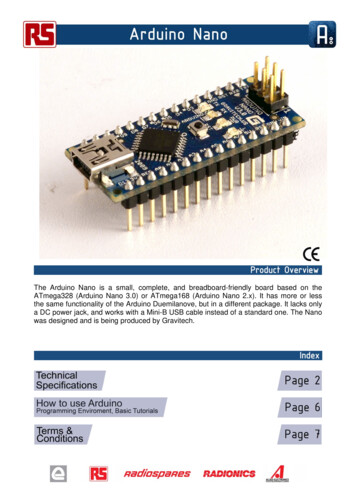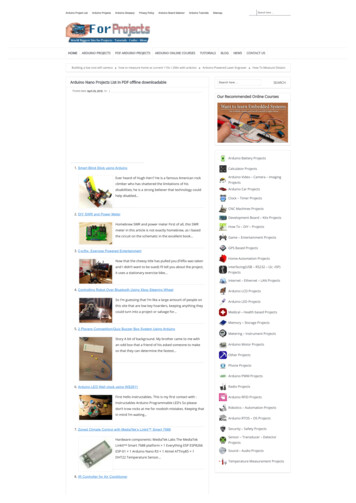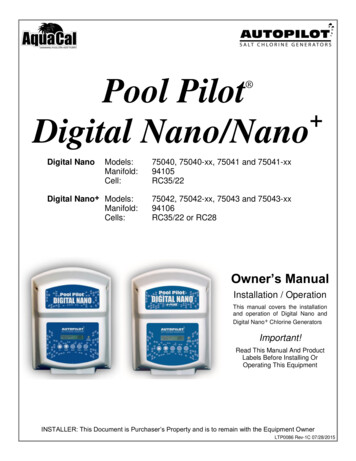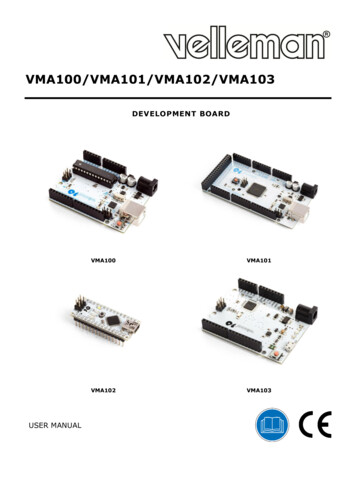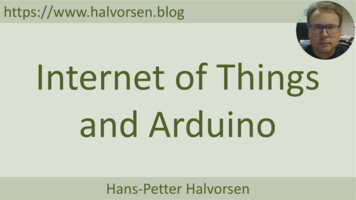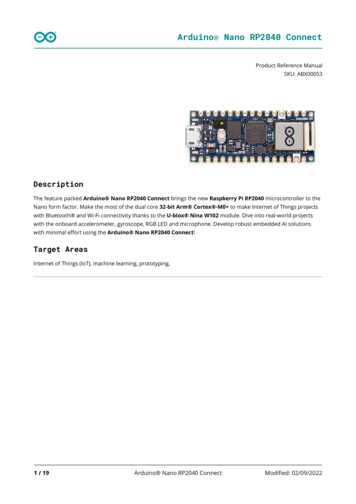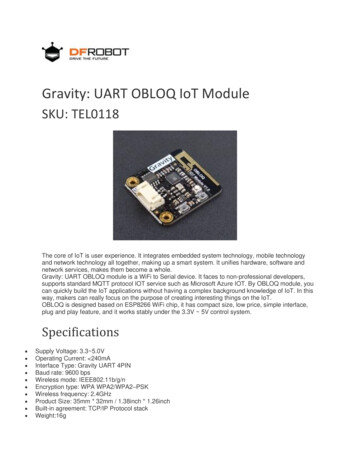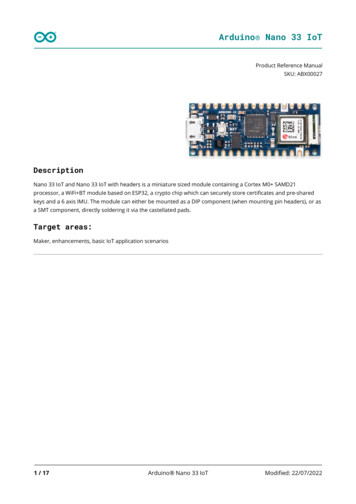
Transcription
Arduino Nano 33 IoTProduct Reference ManualSKU: ABX00027DescriptionNano 33 IoT and Nano 33 IoT with headers is a miniature sized module containing a Cortex M0 SAMD21processor, a WiFi BT module based on ESP32, a crypto chip which can securely store certificates and pre-sharedkeys and a 6 axis IMU. The module can either be mounted as a DIP component (when mounting pin headers), or asa SMT component, directly soldering it via the castellated pads.Target areas:Maker, enhancements, basic IoT application scenarios1 / 17Arduino Nano 33 IoTModified: 22/07/2022
Arduino Nano 33 IoTFeaturesSAMD21G18AProcessor256KB Flash32KB FlashPower On Reset (POR) and Brown Out Detection (BOD)Peripherals12 channel DMA12 channel event system5x 16 bit Timer/Counter3x 24 bit timer/counter with extended functions32 bit RTCWatchdog TimeCRC-32 generatorFull speed Host/Device USB with 8 end points6x SERCOM (USART, I2C, SPI, LIN)Two channel I2S12 bit 350ksps ADC (up to 16 bit with oversampling)10 bit 350ksps DACExternal Interrupt Controller (up to 16 lines)2 / 17Arduino Nano 33 IoTModified: 22/07/2022
Arduino Nano 33 IoTNina W102ModuleDual Core Tensilica LX6 CPU at up to 240MHz448 KB ROM, 520KB SRAM, 2MB FlashWiFiIEEE 802.11b up to 11MbitIEEE 802.11g up to 54MBitIEEE 802.11n up to 72MBit2.4 GHz, 13 channels-96 dBm sensitivityBluetooth BR/EDRMax 7 peripherals2.4 GHz, 79 channelsUp to 3 Mbit/s8 dBm output power at 2/3 Mbit/s11 dBm EIRP at 2/3 Mbit/s-88 dBm sensitivityBluetooth Low EnergyBluetooth 4.2 dual mode2.4GHz 40 channels6 dBm output power9 dBm EIRP-88 dBm sensitivityUp to 1 Mbit/MPM3610 (DC-DC)Regulates input voltage from up to 21V with a minimum of 65% efficiency @minimum loadMore than 85% efficiency @12VATECC608A (Crypto Chip)Cryptographic co-processor with secure hardware based key storageProtected storage for up to 16 keys, certificates or dataECDH: FIPS SP800-56A Elliptic Curve Diffie-HellmanNIST standard P256 elliptic curve supportSHA-256 & HMAC hash including off-chip context save/restoreAES-128 encrypt/decrypt, galois field multiply for GCMLSM6DSL (6 axis IMU)Always-on 3D accelerometer and 3D gyroscopeSmart FIFO up to 4 KByte based 2/ 4/ 8/ 16 g full scale 125/ 250/ 500/ 1000/ 2000 dps full scale3 / 17Arduino Nano 33 IoTModified: 22/07/2022
Arduino Nano 33 IoTContents1 The Board51.1 Application Examples52 Ratings52.1 Recommended Operating Conditions52.2 Power Consumption53 Functional Overview63.1 Board Topology63.2 Processor73.3 WiFi/BT Communication Module73.4 Crypto83.5 IMU83.6 Power Tree84 Board Operation94.1 Getting Started - IDE94.2 Getting Started - Arduino Web Editor94.3 Getting Started - Arduino IoT Cloud94.4 Sample Sketches94.5 Online Resources94.6 Board Recovery105 Connector Pinouts105.1 USB115.2 Headers115.3 Debug126 Mechanical Information126.1 Board Outline and Mounting Holes126.2 Connector Positions137 Certifications147.1 Declaration of Conformity CE DoC (EU)147.2 Declaration of Conformity to EU RoHS & REACH 211 01/19/2021147.3 Conflict Minerals Declaration158 FCC Caution159 Company Information1610 Reference Documentation1611 Revision History174 / 17Arduino Nano 33 IoTModified: 22/07/2022
Arduino Nano 33 IoT1 The BoardAs all Nano form factor boards, Nano 33 IoT and Nano 33 IoT with headers does not have a battery charger but canbe powered through USB or headers.NOTE: Arduino Nano 33 IoT and Nano 33 IoT with headers only supports 3.3V I/Os and is NOT 5V tolerant soplease make sure you are not directly connecting 5V signals to this board or it will be damaged. Also, as opposed toArduino Nano boards that support 5V operation, the 5V pin does NOT supply voltage but is rather connected,through a jumper, to the USB power input.1.1 Application ExamplesWeather station: Using the Arduino Nano 33 IoT or Nano 33 IoT with headers together with a sensor and a OLEDdisplay, we can create a small weather station communicating temperature, humidity etc. directly to your phone.Air quality monitor: Bad air quality may have serious effects on your health. By assembling the board, with asensor and monitor you can make sure that the air quality is kept in indoor-environments. By connecting thehardware assembly to an IoT application/API, you will receive real time values.Air drum: A quick and fun project is to create a small air drum. Connect your board and upload your sketch fromthe Create Web Editor and start creating beats with your audio workstation of your choice.2 Ratings2.1 Recommended Operating ConditionsSymbolDescriptionMinMaxConservative thermal limits for the whole board:-40 C ( 40 F)85 C ( 185 F)2.2 Power imum input voltage from VIN pad-0.3-21VVUSBMaxMaximum input voltage from USB connector-0.3-21VPMaxMaximum Power Consumption--TBCmW5 / 17Arduino Nano 33 IoTModified: 22/07/2022
Arduino Nano 33 IoT3 Functional Overview3.1 Board TopologyBoard topology topRef.DescriptionRef.DescriptionU1ATSAMD21G18A ControllerU3LSM6DSOXTR IMU SensorU2NINA-W102-00B WiFi/BLE ModuleU4ATECC608A-MAHDA-T Crypto ChipJ1Micro USB ConnectorPB1IT-1185-160G-GTR Push buttonBoard topology bottom6 / 17Arduino Nano 33 IoTModified: 22/07/2022
Arduino Nano 33 IoTRef.DescriptionRef.DescriptionSJ1Open solder bridge (VUSB)SJ4Closed solder bridge ( 3V3)TPTest pointsxxLorem Ipsum3.2 ProcessorThe Main Processor is a Cortex M0 running at up to 48MHz. Most of its pins are connected to the externalheaders, however some are reserved for internal communication with the wireless module and the on-boardinternal I2C peripherals (IMU and Crypto).NOTE: As opposed to other Arduino Nano boards, pins A4 and A5 have an internal pull up and default to be usedas an I2C Bus so usage as analog inputs is not recommended.Communication with NINA W102 happens through a serial port and a SPI bus through the following pins.SAMD21 PinSAMD21 AcronymNINA PinNINA AcronymDescription13PA0819RESET NReset39PA2727GPIO0Attention Request41PA287GPIO33Acknowledge23PA1428GPIO5SPI CS21GPIO19UART RTS24PA1529GPIO18SPI CLK20GPIO22UART CTS22PA131GPIO21SPI MISO21PA1236GPIO12SPI MOSI31PA2223GPIO3Processor TX Nina RX32PA2322GPIO1Processor RX Nina TX3.3 WiFi/BT Communication ModuleNina W102 is based on ESP32 and is delivered with a pre-certified software stack from Arduino. Source code for thefirmware is available [9].NOTE: Reprogramming the wireless module’s firmware with a custom one will invalidate compliance with radiostandards as certified by Arduino, hence this is not recommended unless the application is used in privatelaboratories far from other electronic equipment and people. Usage of custom firmware on radio modules is thesole responsibility of the user.Some of the module’s pins are connected to the external headers and can be directly driven by ESP32 providedSAMD21’s corresponding pins are aptly tri-stated. Below is a list of such signals:SAMD21 PinSAMD21 AcronymNINA PinNINA B0931GPIO14A5/SCL7PB0835GPIO13A4/SDA7 / 17Arduino Nano 33 IoTModified: 22/07/2022
Arduino Nano 33 IoT3.4 CryptoThe crypto chip in Arduino IoT boards is what makes the difference with other less secure boards as it provides asecure way to store secrets (such as certificates) and accelerates secure protocols while never exposing secrets inplain text.Source code for the Arduino Library that supports the Crypto is available [10]3.5 IMUThe board has an embedded 6 axis IMU which can be used to measure board orientation (by checking the gravityacceleration vector orientation) or to measure shocks, vibration, acceleration and rotation speed.Source code for the Arduino Library that supports the IMU is available [11]3.6 Power Tree8 / 17Arduino Nano 33 IoTModified: 22/07/2022
Arduino Nano 33 IoTPower tree4 Board Operation4.1 Getting Started - IDEIf you want to program your board while offline you need to install the Arduino Desktop IDE [1] To connect theArduino 33 IoT to your computer, you’ll need a Micro-B USB cable. This also provides power to the board, asindicated by the LED.4.2 Getting Started - Arduino Web EditorAll Arduino boards, including this one, work out-of-the-box on the Arduino Web Editor [2], by just installing a simpleplugin.The Arduino Web Editor is hosted online, therefore it will always be up-to-date with the latest features and supportfor all boards. Follow [3] to start coding on the browser and upload your sketches onto your board.4.3 Getting Started - Arduino IoT CloudAll Arduino IoT enabled products are supported on Arduino IoT Cloud which allows you to Log, graph and analyzesensor data, trigger events, and automate your home or business.4.4 Sample SketchesSample sketches for the Arduino 33 IoT can be found either in the “Examples” menu in the Arduino IDE or in the“Documentation” section of the Arduino Pro website [4]4.5 Online ResourcesNow that you have gone through the basics of what you can do with the board you can explore the endlesspossibilities it provides by checking exciting projects on ProjectHub [5], the Arduino Library Reference [6] and theonline store [7] where you will be able to complement your board with sensors, actuators and more9 / 17Arduino Nano 33 IoTModified: 22/07/2022
Arduino Nano 33 IoT4.6 Board RecoveryAll Arduino boards have a built-in bootloader which allows flashing the board via USB. In case a sketch locks up theprocessor and the board is not reachable anymore via USB it is possible to enter bootloader mode by doubletapping the reset button right after power up.5 Connector PinoutsPinout10 / 17Arduino Nano 33 IoTModified: 22/07/2022
Arduino Nano 33 IoT5.1 USBPin Function TypeDescription1VUSBPowerPower Supply Input. If board is powered via VUSB from header this is an Output(1)2D-Differential USB differential data -3D Differential USB differential data 4IDAnalogSelects Host/Device functionality5GNDPowerPower Ground1. The board can support USB host mode only if powered via the VUSB pin and if the jumper close to the VUSBpin is shorted.5.2 HeadersThe board exposes two 15 pin connectors which can either be assembled with pin headers or soldered throughcastellated vias.Pin FunctionTypeDescription1D13DigitalGPIO2 3V3Power OutInternally generated power output to external devices3AREFAnalogAnalog Reference; can be used as GPIO4A0/DAC0AnalogADC in/DAC out; can be used as GPIO5A1AnalogADC in; can be used as GPIO6A2AnalogADC in; can be used as GPIO7A3AnalogADC in; can be used as GPIO8A4/SDAAnalogADC in; I2C SDA; Can be used as GPIO (1)9A5/SCLAnalogADC in; I2C SCL; Can be used as GPIO (1)10A6AnalogADC in; can be used as GPIO11A7AnalogADC in; can be used as GPIO12VUSBPowerIn/OutNormally NC; can be connected to VUSB pin of the USB connector by shorting ajumper13RSTDigital InActive low reset input (duplicate of pin 18)14GNDPowerPower Ground15VINPower InVin Power input16TXDigitalUSART TX; can be used as GPIO17RXDigitalUSART RX; can be used as GPIO18RSTDigitalActive low reset input (duplicate of pin 13)19GNDPowerPower Ground20D2DigitalGPIO21D3/PWMDigitalGPIO; can be used as PWM22D4DigitalGPIO23D5/PWMDigitalGPIO; can be used as PWM24D6/PWMDigitalGPIO, can be used as PWM25D7DigitalGPIO26D8DigitalGPIO11 / 17Arduino Nano 33 IoTModified: 22/07/2022
Arduino Nano 33 IoTPin FunctionTypeDescription27D9/PWMDigitalGPIO; can be used as PWM28D10/PWM DigitalGPIO; can be used as PWM29D11/MOSI DigitalSPI MOSI; can be used as GPIO30D12/MISO DigitalSPI MISO; can be used as GPIO5.3 DebugOn the bottom side of the board, under the communication module, debug signals are arranged as 3x2 test padswith 100 mil pitch. Pin 1 is depicted in Figure 3 – Connector PositionsPinFunctionTypeDescription1 3V3Power OutInternally generated power output to be used as voltage reference2SWDDigitalSAMD11 Single Wire Debug Data3SWCLKDigital InSAMD11 Single Wire Debug Clock4UPDIDigitalATMega4809 update interface5GNDPowerPower Ground6RSTDigital InActive low reset input6 Mechanical Information6.1 Board Outline and Mounting HolesThe board measures are mixed between metric and imperial. Imperial measures are used to maintain a 100 milpitch grid between pin rows to allow them to fit a breadboard whereas board length is Metric.Layout12 / 17Arduino Nano 33 IoTModified: 22/07/2022
Arduino Nano 33 IoT6.2 Connector PositionsThe view below is from top however it shows Debug connector pads which are on the bottom side. Highlightedpins are pin 1 for each connector’Top view:Top side connectorsBottom view:Bottom side connectors13 / 17Arduino Nano 33 IoTModified: 22/07/2022
Arduino Nano 33 IoT7 Certifications7.1 Declaration of Conformity CE DoC (EU)We declare under our sole responsibility that the products above are in conformity with the essential requirementsof the following EU Directives and therefore qualify for free movement within markets comprising the EuropeanUnion (EU) and European Economic Area (EEA).7.2 Declaration of Conformity to EU RoHS & REACH 211 01/19/2021Arduino boards are in compliance with RoHS 2 Directive 2011/65/EU of the European Parliament and RoHS 3Directive 2015/863/EU of the Council of 4 June 2015 on the restriction of the use of certain hazardous substances inelectrical and electronic equipment.SubstanceMaximum limit (ppm)Lead (Pb)1000Cadmium (Cd)100Mercury (Hg)1000Hexavalent Chromium (Cr6 )1000Poly Brominated Biphenyls (PBB)1000Poly Brominated Diphenyl ethers (PBDE)1000Bis(2-Ethylhexyl} phthalate (DEHP)1000Benzyl butyl phthalate (BBP)1000Dibutyl phthalate (DBP)1000Diisobutyl phthalate (DIBP)1000Exemptions : No exemptions are claimed.Arduino Boards are fully compliant with the related requirements of European Union Regulation (EC) 1907 /2006concerning the Registration, Evaluation, Authorization and Restriction of Chemicals (REACH). We declare none ofthe SVHCs able), the Candidate List of Substances of Very HighConcern for authorization currently released by ECHA, is present in all products (and also package) in quantitiestotaling in a concentration equal or above 0.1%. To the best of our knowledge, we also declare that our productsdo not contain any of the substances listed on the "Authorization List" (Annex XIV of the REACH regulations) andSubstances of Very High Concern (SVHC) in any significant amounts as specified by the Annex XVII of Candidate listpublished by ECHA (European Chemical Agency) 1907 /2006/EC.14 / 17Arduino Nano 33 IoTModified: 22/07/2022
Arduino Nano 33 IoT7.3 Conflict Minerals DeclarationAs a global supplier of electronic and electrical components, Arduino is aware of our obligations with regards tolaws and regulations regarding Conflict Minerals, specifically the Dodd-Frank Wall Street Reform and ConsumerProtection Act, Section 1502. Arduino does not directly source or process conflict minerals such as Tin, Tantalum,Tungsten, or Gold. Conflict minerals are contained in our products in the form of solder, or as a component inmetal alloys. As part of our reasonable due diligence Arduino has contacted component suppliers within our supplychain to verify their continued compliance with the regulations. Based on the information received thus far wedeclare that our products contain Conflict Minerals sourced from conflict-free areas.8 FCC CautionAny Changes or modifications not expressly approved by the party responsible for compliance could void the user’sauthority to operate the equipment.This device complies with part 15 of the FCC Rules. Operation is subject to the following two conditions:(1) This device may not cause harmful interference(2) this device must accept any interference received, including interference that may cause undesired operation.FCC RF Radiation Exposure Statement:1. This Transmitter must not be co-located or operating in conjunction with any other antenna or transmitter.2. This equipment complies with RF radiation exposure limits set forth for an uncontrolled environment.3. This equipment should be installed and operated with minimum distance 20cm between the radiator &your body.English: User manuals for license-exempt radio apparatus shall contain the following or equivalent notice in aconspicuous location in the user manual or alternatively on the device or both. This device complies with IndustryCanada license-exempt RSS standard(s). Operation is subject to the following two conditions:(1) this device may not cause interference(2) this device must accept any interference, including interference that may cause undesired operation of thedevice.French: Le présent appareil est conforme aux CNR d’Industrie Canada applicables aux appareils radio exempts delicence. L’exploitation est autorisée aux deux conditions suivantes :(1) l’ appareil nedoit pas produire de brouillage(2) l’utilisateur de l’appareil doit accepter tout brouillage radioélectrique subi, même si le brouillage est susceptibled’en compromettre le fonctionnement.IC SAR Warning:English This equipment should be installed and operated with minimum distance 20 cm between the radiator andyour body.French: Lors de l’ installation et de l’ exploitation de ce dispositif, la distance entre le radiateur et le corps est d ’aumoins 20 cm.15 / 17Arduino Nano 33 IoTModified: 22/07/2022
Arduino Nano 33 IoTImportant: The operating temperature of the EUT can’t exceed 85 and shouldn’t be lower than -40 .Hereby, Arduino S.r.l. declares that this product is in compliance with essential requirements and other relevantprovisions of Directive 2014/53/EU. This product is allowed to be used in all EU member states.Frequency bandsMaximum output power (EIRP)2402-2480MHz(EDR)6.24 dBm2402-2480MHz(BLE)6.30 dBm2412-2472MHz(2.4G WiFi)13.61 dBm9 Company InformationCompany nameArduino S.r.lCompany AddressVia Andrea Appiani,2520900 MONZA10 Reference DocumentationReferenceLinkArduino eArduino IDE (Cloud)https://create.arduino.cc/editorCloud IDE /Arduino dfNINA A-W10 DataSheet 610 r1.01.pdfNINA Firmwarehttps://github.com/arduino/nina-fwECC608 oECCX08LSM6DSL tHubhttps://create.arduino.cc/projecthub?by part&part id 11332&sort trendingLibrary no Storehttps://store.arduino.cc/16 / 17Arduino Nano 33 IoTModified: 22/07/2022
Arduino Nano 33 IoT11 Revision HistoryDateRevisionChanges04/15/20211General datasheet updates17 / 17Arduino Nano 33 IoTModified: 22/07/2022
9 / 1 7 Arduino Nano 33 IoT Modified: 17/07/2022 P ow er t r ee 4 Board Operation 4.1 Getting Started - IDE If you want to program your board while offline you need to install the Arduino Desktop IDE [1] To connect the Arduino 33 IoT to your computer, you'll need a Micro-B USB cable. This also provides power to the board, as indicated by .
